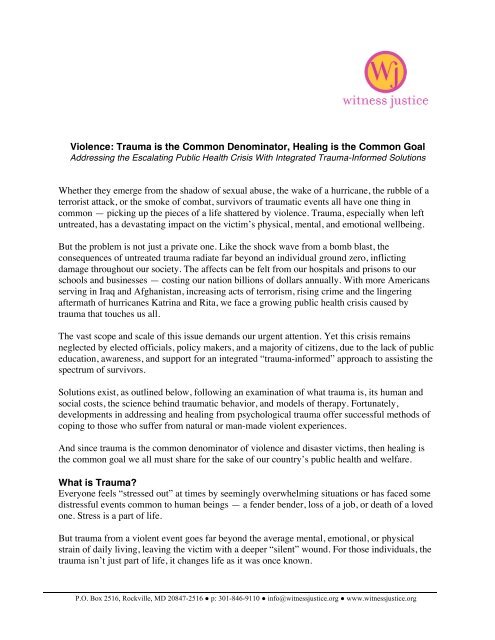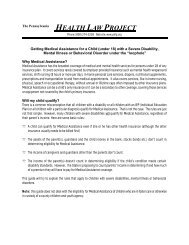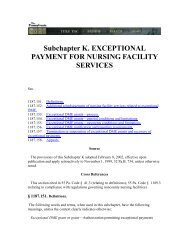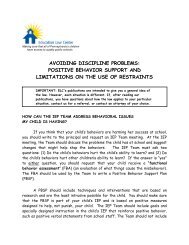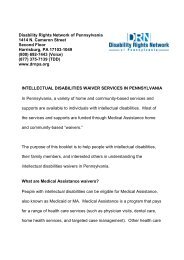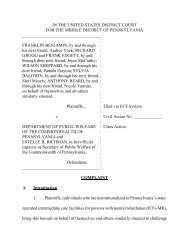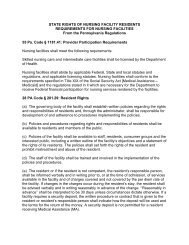Trauma is the Common Denominator, Healing is the Common Goal ...
Trauma is the Common Denominator, Healing is the Common Goal ...
Trauma is the Common Denominator, Healing is the Common Goal ...
- No tags were found...
You also want an ePaper? Increase the reach of your titles
YUMPU automatically turns print PDFs into web optimized ePapers that Google loves.
Violence: <strong>Trauma</strong> <strong>is</strong> <strong>the</strong> <strong>Common</strong> <strong>Denominator</strong>, <strong>Healing</strong> <strong>is</strong> <strong>the</strong> <strong>Common</strong> <strong>Goal</strong>Addressing <strong>the</strong> Escalating Public Health Cr<strong>is</strong><strong>is</strong> With Integrated <strong>Trauma</strong>-Informed SolutionsWhe<strong>the</strong>r <strong>the</strong>y emerge from <strong>the</strong> shadow of sexual abuse, <strong>the</strong> wake of a hurricane, <strong>the</strong> rubble of aterror<strong>is</strong>t attack, or <strong>the</strong> smoke of combat, survivors of traumatic events all have one thing incommon — picking up <strong>the</strong> pieces of a life shattered by violence. <strong>Trauma</strong>, especially when leftuntreated, has a devastating impact on <strong>the</strong> victim’s physical, mental, and emotional wellbeing.But <strong>the</strong> problem <strong>is</strong> not just a private one. Like <strong>the</strong> shock wave from a bomb blast, <strong>the</strong>consequences of untreated trauma radiate far beyond an individual ground zero, inflictingdamage throughout our society. The affects can be felt from our hospitals and pr<strong>is</strong>ons to ourschools and businesses — costing our nation billions of dollars annually. With more Americansserving in Iraq and Afghan<strong>is</strong>tan, increasing acts of terror<strong>is</strong>m, r<strong>is</strong>ing crime and <strong>the</strong> lingeringaftermath of hurricanes Katrina and Rita, we face a growing public health cr<strong>is</strong><strong>is</strong> caused bytrauma that touches us all.The vast scope and scale of th<strong>is</strong> <strong>is</strong>sue demands our urgent attention. Yet th<strong>is</strong> cr<strong>is</strong><strong>is</strong> remainsneglected by elected officials, policy makers, and a majority of citizens, due to <strong>the</strong> lack of publiceducation, awareness, and support for an integrated “trauma-informed” approach to ass<strong>is</strong>ting <strong>the</strong>spectrum of survivors.Solutions ex<strong>is</strong>t, as outlined below, following an examination of what trauma <strong>is</strong>, its human andsocial costs, <strong>the</strong> science behind traumatic behavior, and models of <strong>the</strong>rapy. Fortunately,developments in addressing and healing from psychological trauma offer successful methods ofcoping to those who suffer from natural or man-made violent experiences.And since trauma <strong>is</strong> <strong>the</strong> common denominator of violence and d<strong>is</strong>aster victims, <strong>the</strong>n healing <strong>is</strong><strong>the</strong> common goal we all must share for <strong>the</strong> sake of our country’s public health and welfare.What <strong>is</strong> <strong>Trauma</strong>?Everyone feels “stressed out” at times by seemingly overwhelming situations or has faced somed<strong>is</strong>tressful events common to human beings — a fender bender, loss of a job, or death of a lovedone. Stress <strong>is</strong> a part of life.But trauma from a violent event goes far beyond <strong>the</strong> average mental, emotional, or physicalstrain of daily living, leaving <strong>the</strong> victim with a deeper “silent” wound. For those individuals, <strong>the</strong>trauma <strong>is</strong>n’t just part of life, it changes life as it was once known.P.O. Box 2516, Rockville, MD 20847-2516 ● p: 301-846-9110 ● info@witnessjustice.org ● www.witnessjustice.org
The American Psychiatric Association’s Diagnostic and Stat<strong>is</strong>tical Manual (DSM-IV) defines a“traumatic event” as one in which a person experiences, witnesses, or <strong>is</strong> confronted with actualor threatened death or serious injury, or threat to <strong>the</strong> physical integrity of oneself or o<strong>the</strong>rs. Aperson’s response to trauma often includes intense fear, helplessness, or sheer horror. 1 <strong>Trauma</strong>can result from experiences that are “private” (e.g. sexual assault, domestic violence, childabuse/neglect, witnessing interpersonal violence) or more “public” (e.g. war, terror<strong>is</strong>m, naturald<strong>is</strong>asters).Medical researchers, sociolog<strong>is</strong>ts, and healthcare professionals increasingly recognize trauma asa significant factor in a wide range of health, behavioral health, and social problems. 2 3 <strong>Trauma</strong>resulting from prolonged or repeated exposures to violent events can be <strong>the</strong> most severe. 4Clearly, different individuals react to trauma in <strong>the</strong>ir own way, depending on <strong>the</strong> nature of andcircumstances surrounding <strong>the</strong>ir traumatic experiences. For example, trauma associated withrepeated childhood physical or sexual abuse can become a central defining character<strong>is</strong>tic to asurvivor’s identity, impacting nearly every aspect of h<strong>is</strong> or her life. Regardless of its cause,trauma <strong>is</strong> a central mental health concern and a “common denominator” for violence and d<strong>is</strong>astervictims.The Human Cost<strong>Trauma</strong> can have severe negative impacts on a person’s physical and emotional state. The mostcommon experiences include flashbacks, emotional numbness and withdrawal, nightmares andinsomnia, mood swings, grief, guilt, d<strong>is</strong>trust, and a lack of physical or sexual intimacy. <strong>Trauma</strong>has been linked to hallucinations and delusions, depression, suicidal tendencies, chronic anxietyand fatigue, hostility, hypersensitivity, eating d<strong>is</strong>orders such as anorexia or obesity, and o<strong>the</strong>robsessive behaviors. 5Victims are at a much higher r<strong>is</strong>k for co-occurring mental health d<strong>is</strong>orders and substance abuse,violence victimization and perpetration, self-injury, and a host of o<strong>the</strong>r coping mechan<strong>is</strong>mswhich <strong>the</strong>mselves have devastating human, social, and economic costs. <strong>Trauma</strong> has been linkedto social, emotional, and cognitive impairments, d<strong>is</strong>ease, d<strong>is</strong>ability, serious social problems, andpremature death. 6In fact, between 51 percent and 98 percent of public mental health clients diagnosed with severemental illness have trauma h<strong>is</strong>tories, 7 and prevalence rates within substance abuse treatmentprograms and o<strong>the</strong>r social services are similar. 8 In children, trauma may be incorrectlydiagnosed as depression, attention deficit hyperactivity d<strong>is</strong>order (ADHD), oppositional defiantd<strong>is</strong>order (ODD), conduct d<strong>is</strong>order, generalized anxiety d<strong>is</strong>order, separation anxiety d<strong>is</strong>order, andreactive attachment d<strong>is</strong>order. 9 10 Adults also encounter similar m<strong>is</strong>diagnos<strong>is</strong> and obstacles inhaving <strong>the</strong>ir trauma experiences understood and addressed.The Adverse Childhood Experiences (ACE) study, which examined <strong>the</strong> health and social effectsof traumatic childhood experiences over <strong>the</strong> lifespan of 18,000 participants, demonstrated thattrauma <strong>is</strong> far more prevalent than previously recognized, that <strong>the</strong> impacts of trauma arecumulative, and that unaddressed trauma underlies a wide range of problems. Chronic medicalconditions such as heart d<strong>is</strong>ease, cancer, lung and liver d<strong>is</strong>ease, skeletal fractures, and HIV-AIDSP.O. Box 2516, Rockville, MD 20847-2516 ● p: 301-846-9110 ● info@witnessjustice.org ● www.witnessjustice.org
plague many trauma survivors. Also, a host of social ills from homelessness, prostitution,delinquency and criminal behavior, to <strong>the</strong> failure to fin<strong>is</strong>h school or an inability to hold a job,11 12 13stem from <strong>the</strong> effects of a traumatic event. Fractured relationships and support systemsalso greatly impact <strong>the</strong> survivor and <strong>the</strong>ir ability to heal.The Public Price Tag of Untreated <strong>Trauma</strong>When undiagnosed and untreated trauma manifests itself as civic problems, we all foot <strong>the</strong> bill. Itcan significantly increase <strong>the</strong> use of health care and behavioral health services, as well as boostsincarceration rates and increases <strong>the</strong> need for victim compensation and services. For instance, weknow that more than 40% of women on welfare were sexually abused as children. 14 So taxpayers<strong>the</strong>n pick up <strong>the</strong> tab for <strong>the</strong> greater reliance on public resources such as Medicare, Medicaid, ando<strong>the</strong>r welfare programs, plus <strong>the</strong> strain on <strong>the</strong> law enforcement, court, victim service, and pr<strong>is</strong>onsystems. Meanwhile trauma costs business and <strong>the</strong> American economy in decreased productivityand unemployment payments.And <strong>the</strong> financial burden to society <strong>is</strong> staggering. The economic expenditures of untreatedtrauma-related alcohol and drug abuse alone were estimated at $160.7 billion in 2000. 15 Theestimated cost to society of child abuse and neglect <strong>is</strong> $94 billion per year, or $258 million perday. 16 For child abuse survivors, long-term psychiatric and medical health care costs areestimated at $100 billion per year. 17 Lost productivity from violence accounted for $64.4 billionannually, with ano<strong>the</strong>r $5.6 billion spent in medical care. 18A Multiplier Effect: D<strong>is</strong>astersResearch on <strong>the</strong> consequences of recent public d<strong>is</strong>asters, including <strong>the</strong> 1995 Oklahoma Citybombing, <strong>the</strong> 2002 Challenger d<strong>is</strong>aster, <strong>the</strong> September 11, 2001 terror<strong>is</strong>t attacks, and hurricanesKatrina and Rita illustrates that d<strong>is</strong>asters can induce severe and long-term trauma, particularly inthose with prior h<strong>is</strong>tories of mental health problems, addiction, or trauma. 19 20 21 All d<strong>is</strong>astervictims are likely to experience some form of trauma. While many d<strong>is</strong>aster survivors “recover”from grief and shock after a few months, 25 percent to 30 percent of those directly affected maydevelop full-blown Post-traumatic Stress D<strong>is</strong>order (PTSD), 22 23 with <strong>the</strong> surfacing of increasedsubstance abuse, child abuse taking place months later. Domestic violence incidents can increase30 percent to 50 percent within three to six months following a d<strong>is</strong>aster in those communitiesaffected. 24People with severe mental illness, addictions, and previous h<strong>is</strong>tories of trauma are particularlyvulnerable to <strong>the</strong> psychological impact of d<strong>is</strong>asters. 25 26 People with prior exposure to domesticviolence (including physical or sexual abuse) in childhood or adulthood have significantlyheightened susceptibility to severe and chronic PTSD following exposure to any type oftraumatic event. 27 28 29 Similarly, refugees who had been previously traumatized in <strong>the</strong>ir nativecountries and who had been diagnosed with PTSD are at r<strong>is</strong>k. 30For those with previous trauma h<strong>is</strong>tories, PTSD symptoms, and/or substance abuse problems,trauma symptoms can actually increase with time following a d<strong>is</strong>aster. Often <strong>the</strong>y are able tomaintain stability during <strong>the</strong> initial cr<strong>is</strong><strong>is</strong>, but after <strong>the</strong> immediate cr<strong>is</strong><strong>is</strong> passes, <strong>the</strong>y may reexperiencethoughts, emotions, symptoms, and anxiety levels like those associated with <strong>the</strong>irP.O. Box 2516, Rockville, MD 20847-2516 ● p: 301-846-9110 ● info@witnessjustice.org ● www.witnessjustice.org
<strong>the</strong>ir recovery are well equipped to help o<strong>the</strong>rs face <strong>the</strong> same challenges. In fact, it’s been shownthat <strong>the</strong> shift from a passive victim to a proactive survivor offering leadership and support plays avaluable role in <strong>the</strong> peer-provider’s own relief from trauma. In addition, peer-counselors helpreduce <strong>the</strong> burden on <strong>the</strong> often undersized, overwhelmed professional staff. These peer-basedprograms emphasize outreach, focus on people’s strengths, avoid mental health labels, occur inlocal settings, offer social support, and are more culturally sensitive because <strong>the</strong>y are deliveredby people who are <strong>the</strong>mselves community members. Notable examples of successful peersupportprograms include Oklahoma City following <strong>the</strong> Murrah Building bombing, New YorkCity after 9/11, and Lou<strong>is</strong>iana in <strong>the</strong> wake of hurricanes Katrina and Rita. 39 Many states are stillin <strong>the</strong> early stages of developing a network of peer-support services in preparation for d<strong>is</strong>asters,and unfortunately, no peer response model currently ex<strong>is</strong>ts for those trauma victims in <strong>the</strong>criminal justice area.Resilience development <strong>is</strong> ano<strong>the</strong>r exciting, proactive innovation for <strong>the</strong> prevention as well astreatment of trauma. Denn<strong>is</strong> Charney, M.D., Ph.D., dean of research and professor of psychiatryat Mt. Sinai School of Medicine, believes that through focused training and cognitive behavioral<strong>the</strong>rapy, people can be inoculated against stress. “You can learn to recognize your own characterstrengths and engage <strong>the</strong>m to deal with difficult and stressful situations,” he notes. Charney andYale psychiatry professor Steven Southwick, M.D., identified personality traits associated withresilience in 250 American POWs held captive for up to eight years in <strong>the</strong> Vietnam War, whowere subjected to torture and solitary confinement. Then in two o<strong>the</strong>r studies, <strong>the</strong>y interviewedwomen who had suffered severe trauma from sexual and physical abuse, and a group of peoplewho d<strong>is</strong>played courage and resilience in <strong>the</strong> face of serious medical problems. All three groupsshared <strong>the</strong> same character<strong>is</strong>tics of resilience: optim<strong>is</strong>m, cognitive flexibility, altru<strong>is</strong>m, strong orheroic role models, adeptness at facing fears, physical fitness, a supportive social network, activecoping skills, a sense of humor, and a personal moral compass or shatterproof set of beliefs.Fostering those character<strong>is</strong>tics will help people deal with adversity when it occurs and recoverfaster from a traumatic event. 40<strong>Trauma</strong>-Informed Services — Solutions for <strong>the</strong> Growing Public Health Cr<strong>is</strong><strong>is</strong>Recent public d<strong>is</strong>asters, such as 9/11 and Hurricane Katrina, have provided a new sense ofurgency for <strong>the</strong> long-standing need for trauma education and awareness-building among allorganizations, institutions, and agencies that come into contact with survivors of violent events.When a program moves toward becoming trauma-informed, every part of its organization,management, and service delivery system <strong>is</strong> assessed and potentially modified to include a basicknowledge of how trauma impacts <strong>the</strong> life of <strong>the</strong> individual seeking help. <strong>Trauma</strong>-informedsystems are based on an understanding of <strong>the</strong> vulnerabilities or triggers of trauma survivors thattraditional approaches may actually aggravate or intensify, making th<strong>is</strong> new generation ofprograms more supportive and less likely to re-traumatize <strong>the</strong> victim.Th<strong>is</strong> <strong>is</strong> necessary to promote <strong>the</strong> health and wellbeing of survivors and <strong>the</strong>ir families, and to set<strong>the</strong> stage for health and mental health professionals, organizations providing services to traumasurvivors, law enforcement and criminal justice officials, emergency responders, and o<strong>the</strong>rs toeffectively and seamlessly integrate trauma understanding into <strong>the</strong>ir ex<strong>is</strong>ting programs andprocedures.P.O. Box 2516, Rockville, MD 20847-2516 ● p: 301-846-9110 ● info@witnessjustice.org ● www.witnessjustice.org
And <strong>the</strong>re <strong>is</strong> no time to lose in developing trauma-informed solutions for <strong>the</strong> growing populationof violence and d<strong>is</strong>aster victims. In a Sept. 29, 2006, letter to President Bush, <strong>the</strong> U.S. House ofRepresentatives Bipart<strong>is</strong>an Caucus on Addiction, Treatment, and Recovery stated:“It has become more clear than ever psychological trauma <strong>is</strong> a primary — but often ignored oroverlooked — factor of health (both physical and mental) with which survivors of violent crime,abuse, d<strong>is</strong>aster, terror<strong>is</strong>m and war must contend, and th<strong>is</strong> presents a public health cr<strong>is</strong><strong>is</strong> in <strong>the</strong>United States that needs to be addressed immediately.”Witness Justice agrees, and continues to advocate not only for education and awareness on <strong>the</strong><strong>is</strong>sue, but also for:• Leg<strong>is</strong>lators to consider how psychological trauma may play a role in pending or futureleg<strong>is</strong>lation, including policy that addresses d<strong>is</strong>aster preparedness and response, nationaldefense and our armed forces, plus initiatives on crime (domestic violence, sexualassault, stalking, child abuse/neglect), mental health, education, homelessness, and more• Inclusion of programs, services, and funding in leg<strong>is</strong>lation that addresses trauma andprovides short-term, intermediate, and long-term support through <strong>the</strong> healing process• Development and implementation of prevention measures, such as peer-support servicenetworks and resilience training education• More support for efforts that address psychological trauma through new models withproven track records of success, such as peer-supportIn addition, Witness Justice recently launched a new advocacy program, Survivors TakingAction, that <strong>is</strong> <strong>the</strong> first of its kind in <strong>the</strong> nation. Th<strong>is</strong> initiative brings toge<strong>the</strong>r interest groups forcrime victimization, child abuse, veterans’ <strong>is</strong>sues, d<strong>is</strong>aster preparedness, homelessness, substanceabuse, mental health, and more to tackle <strong>the</strong> “common denominator” of trauma. The goal <strong>is</strong> toreach all those who attempt to live under <strong>the</strong> cloud cast by violence, whe<strong>the</strong>r natural or manmade,and provide <strong>the</strong> light of both hope, healing, and support for <strong>the</strong>m, <strong>the</strong>ir families, and for<strong>the</strong> health and wellbeing of America.Authored by Helga Luest, President & CEO, Witness Justice© 2007 Witness Justice1 American Psychiatric Association. (2000). Diagnostic and stat<strong>is</strong>tical manual of mental d<strong>is</strong>orders (DSM IV-TR), fourth edition.Washington, DC: APA.2 Felitti, V. J. (2003). The Relationship of Adverse Childhood Experiences to Adult Health Status. Presented September 2003at <strong>the</strong> "Snowbird Conference" of <strong>the</strong> Child <strong>Trauma</strong> Treatment Network of <strong>the</strong> Intermountain West. DVD publ<strong>is</strong>hed by TheNational Child <strong>Trauma</strong>tic Stress Network.P.O. Box 2516, Rockville, MD 20847-2516 ● p: 301-846-9110 ● info@witnessjustice.org ● www.witnessjustice.org
3 Felitti, V., Anda, R., Nordenberg, D., Williamson, D., Spitz, A., Edwards, V., Koss, M., Marks, J. (1998). Relationship ofchildhood abuse and household dysfunction to many of <strong>the</strong> leading causes of death in adults: The adverse childhood experiences(ACE) study. American Journal of Preventive Medicine, 14(4), 245-258.4National Child <strong>Trauma</strong>tic Stress Network Complex <strong>Trauma</strong> Task Force (2003). Complex trauma in children and adolescents:white paper.Eds. Cook A., Blaustein, M., Spinazzola, J., vanderKolk, B.5Mueser, KI., Rosenberg, S., Goodman, L., & Trumbetta, S. (2002). <strong>Trauma</strong>, PTSD, and <strong>the</strong> course of severe mental illness: aninteractive model. Schizophrenia Research, 53, 123-1436 Anda, R., Felitti, V., Walker, J., Whitfield, C., Bremner, J., Perry, B., Dube, S., Giles, W. The enduring effects of abuse andrelated adverse experiences in childhood: A convergence of evidence from neurobiology and epidemiology. (Submitted forpublication) (ACE Study).7 Mueser, K., Goodman, L.A., Trumbetta, S.L., Rosenberg, S.D., Osher, F.C., Vidaver, R., Auciello, P., & Foy, E.W. (1998).<strong>Trauma</strong> and post-traumatic stress d<strong>is</strong>order in severe mental illness. Journal of Consulting and Clinical Psychology, 66, 493-499.8 Center for Substance Abuse Treatment. (2000). Substance abuse treatment for persons with child abuse and neglect <strong>is</strong>suesTreatment Improvement Protocol (TIP) series. (DHHS Publication No. SMA 00-3357, Number 36. Washington, DC: U.S.Government Printing Office.9 The Science of Early Childhood Development: Closing <strong>the</strong> Gap Between What We Know and What We Do. Jack P. Shonkoff,Dean of <strong>the</strong> Heller School for Social Policy and Management, and Chair of <strong>the</strong> National Scientific Council on <strong>the</strong> DevelopingChild. Presentation to <strong>the</strong> 15 th National Conference on Child Abuse and neglect, Boston, MA April 19, 2005. Powerpoint:National Scientific Council on <strong>the</strong> Developing Child.10Cook, A., Blaustein, M., Spinazzola, J., and van der Kolk, B. (2003). Complex trauma in children and adolescents: WhitePaper from <strong>the</strong> National Child <strong>Trauma</strong>tic Stress Network: Complex <strong>Trauma</strong> Task Force.11 Felitti, V., Anda, R., Nordenberg, D., Williamson, D., Spitz, A., Edwards, V., Koss, M., Marks, J. (1998). Relationship ofchildhood abuse and household dysfunction to many of <strong>the</strong> leading causes of death in adults: The adverse childhood experiences(ACE) study. American Journal of Preventive Medicine, 14(4), 245-258.12 Felitti, V. J. (2003). The Relationship of Adverse Childhood Experiences to Adult Health Status. Presented September 2003at <strong>the</strong> "Snowbird Conference" of <strong>the</strong> Child <strong>Trauma</strong> Treatment Network of <strong>the</strong> Intermountain West. DVD publ<strong>is</strong>hed by TheNational Child <strong>Trauma</strong>tic Stress Network.13 See www.ACEstudy.org14 Mueser et. al., in press; Mueser et. al.(1998).15 The Economic Costs of Drug Abuse in <strong>the</strong> United States 1992-1998. Report prepared by The Lewin Group.16 Prevent Child Abuse America. (2001). Total estimated cost of child abuse and neglect in <strong>the</strong> United States: Stat<strong>is</strong>ticalevidence. Report funded by <strong>the</strong> Edna McConnell Clark Foundation.17 The Ross Institute (www.rossinst.com)18 Centers for D<strong>is</strong>ease Control and Prevention study, publ<strong>is</strong>hed in <strong>the</strong> American Journal of Preventive Medicine (June 2007)19 Galea, S., Ahern, J., Resnick, H., Kilpatrick, D., Bucuvalas, M., Gold, J., & Vlahov, D. (March 28, 2002). Psychologicalsequelae of <strong>the</strong> September 11 terror<strong>is</strong>t attacks in New York City. New England Journal of Medicine, Vol. 346, No. 13, pp. 982-98720 Terr, L. C., Bloch, D. A., Michel, B. A., Shi, H., Reinhardt, J. A., & Metayer, S. (1999). Children's symptoms in <strong>the</strong> wake ofChallenger: a field study of d<strong>is</strong>tant-traumatic effects and an outline of related conditions. American Journal of Psychiatry, 156,1536-1544.21 Breslau, N., Chilcoat, H. D., Kessler, R. C., Dav<strong>is</strong>, G. C. (1999). Previous exposure to trauma and PTSD effects of subsequenttrauma: Results from <strong>the</strong> Detroit Area Survey of <strong>Trauma</strong>. American Journal of Psychiatry, 156:902-907.P.O. Box 2516, Rockville, MD 20847-2516 ● p: 301-846-9110 ● info@witnessjustice.org ● www.witnessjustice.org
22 North, C.S. (2001). The course of post-traumatic stress d<strong>is</strong>order after <strong>the</strong> Oklahoma City bombing. Mil Med, 166 (12 Suppl):51-223Abenhaim, L., Dab, W., & Salmi, L. R. (February 1992). Study of civilian victims of terror<strong>is</strong>t attacks (France 1982-1987).Journal of Clinical Epidemiol, 45(2);103-9.24Norr<strong>is</strong>, F. H. Prevalence and impact of domestic violence in <strong>the</strong> wake of d<strong>is</strong>asters. A National Center for PTSD Fact Sheet.(See www.ncptsd.org/facts/d<strong>is</strong>asters/fs_domestic.html)25 North, C., Nixon, S., Shariat, S., Mallonee, S., McMillen, J., Spitzanagel, E., & Smith, E. (1999). Psychiatric d<strong>is</strong>orders amongsurvivors of <strong>the</strong> Oklahoma City bombing. Journal of <strong>the</strong> American Medical Association, 282, 755-762.26 Mueser, K. T., Trumbetta, S. L., Rosenberg, S. D., Vidaver, R. M., Goodman, L. B., Osher, F. C., Auciello, P., Foy, D. W.(1998). <strong>Trauma</strong> and Posttraumatic Stress D<strong>is</strong>order in severe mental illness. Journal of Consulting and Clinical Psychology, 66(3),493-499.27 North, C., Nixon, S., Shariat, S., Mallonee, S., McMillen, J., Spitzanagel, E., & Smith, E. (1999). Psychiatric d<strong>is</strong>orders amongsurvivors of <strong>the</strong> Oklahoma City bombing. Journal of <strong>the</strong> American Medical Association, 282, 755-762.28King et al. (1999). Stretch, Knudson, & Durand (1998). Bremner, Southwick, Brett, & Fontant (1992). Breslau et al. (1998).Green et al. (2000). N<strong>is</strong>hith, Mechanic, & Resnick (2000). In B. Litz, M. Gray, R. Bryant, & A. Adler. Early intervention fortrauma: Current status and future directions. A National Center for PTSD Fact Sheet. Seewww.ncptsd.org/facts/d<strong>is</strong>asters/fs_earlyint_d<strong>is</strong>aster.html29 Breslau, N., Chilcoat, H. D., Kessler, R. C., Dav<strong>is</strong>, G. C. (1999). Previous exposure to trauma and PTSD effects of subsequenttrauma: Results from <strong>the</strong> Detroit Area Survey of <strong>Trauma</strong>. American Journal of Psychiatry, 156:902-907.30Kinzie, J. D., Boehnlein, J. K., Riley, C., Sparr, L. (July 2002). The effects of September 11 on traumatized refugees:Reactivation of Post <strong>Trauma</strong>tic Stress D<strong>is</strong>order. J Nerv Ment D<strong>is</strong>, 190(7):437-4131 Nader, K. (1998). Violence: Effects of a parents’ previous trauma on currently traumatized children. In Y. Danieli (Ed.), Aninternational handbook of multigenerational legacies of trauma (pp. 571-583), New York, NY: Plenum Press.32 Brewin, C. R., Andrews, B., Valentine, J. D. (2000). Meta-analys<strong>is</strong> of r<strong>is</strong>k factors for Posttraumatic Stress D<strong>is</strong>order in traumaexposedadults. J of Consulting and Clinical Psychology, 68:748-766.33Hull, A. (2002). Neuroimaging findings in post-traumatic stress d<strong>is</strong>order. Brit<strong>is</strong>h Journal of Psychiatry, 181, 102-110.34Van der Kolk, B., Pelcovitz, D., Roth, S., Mandel, F., McFarlene, A., Herman, J. D<strong>is</strong>sociation, affect dysregulation andsomatization: The complex nature of adaptation to trauma. May 200535 Anda, R., Felitti, V., Walker, J., Whitfield, C., Bremner, J., Perry, B., Dube, S., Giles, W. The enduring effects of abuse andrelated adverse experiences in childhood: A convergence of evidence from neurobiology and epidemiology. (Submitted forpublication) (ACE Study).36 Bessel van der Kolk. (2002) In Terror’s Grip: <strong>Healing</strong> <strong>the</strong> Ravages of <strong>Trauma</strong>. Cerebrum, 4, 34-50. NY: The DanaFoundation.37 Peter A. Levine, Ph.D. (1997) Waking <strong>the</strong> Tiger: <strong>Healing</strong> <strong>Trauma</strong>: The Innate Capacity To Transform OverwhelmingExperiences. Berkeley: North Atlantic Books.38 The National Center for <strong>Trauma</strong> Informed Care, www.mentalhealth.samhsa.gov/nctic/trauma.asp39 Daniel F., Rote K., Miller L., Romprey D. and Filson D. From Relief to Recovery: Peer Support by ConsumersRelieves <strong>the</strong> <strong>Trauma</strong>s of D<strong>is</strong>asters and Recovery from Mental Illness. Resource paper presented at <strong>the</strong> After <strong>the</strong>Cr<strong>is</strong><strong>is</strong>: <strong>Healing</strong> from <strong>Trauma</strong> after D<strong>is</strong>asters meeting, April 24-25, 2006, Be<strong>the</strong>sda, Md. Updated July 2006.40 “People Can Learn Markers on Road to Resilience,” Psychiatry News, January 19, 2007, Vol. 42, No. 2, p. 5.P.O. Box 2516, Rockville, MD 20847-2516 ● p: 301-846-9110 ● info@witnessjustice.org ● www.witnessjustice.org


